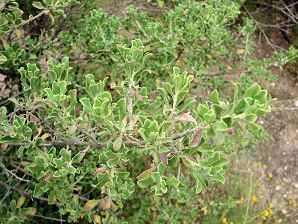Xeriscape Landscaping Plants For The Arizona Desert Environment.
Pictures, Photos, Information
Descriptions, Images, & Reviews.
Shrubs.
Langman's Sage, Leucophyllum langmaniae.
We Are Proud Of Our SafeSurf Rating!
Click On Any Of The Following Links By Amazon.Com
For Books, & Videos About Wildflowers Of Arizona & The Southwest USA. No Obligation!
| Langman's Sage, Leucophyllum langmaniae. Photos Taken: May 13, 2008. Boyce Thompson Arboretum, Near Superior, Arizona. |
|---|
 | |
| Langman's Sage. Leucophyllum langmaniae. | Langman's Sage. Leucophyllum langmaniae. |
|---|
 /
/

Langman's Sage.
We wish to thank Wikipedia, the free encyclopedia for some of the information on this page. We share images and information with Wikipedia. Leucophyllum langmaniae is called "Langman's Sage", in Arizona. In other parts of the US, it comes under other names. In any case it is a dense growing, evergreen shrub that has a rounded form, deep green leaves, and lavender flowers. Several years ago the Texas Ranger (Leucophyllum frutescens), became a staple in desert landscapes, but we now have two other choices, that are thought to be better. These are the two clones of Leucophyllum langmaniae that are now on the market. Leucophyllum langmaniae 'Rio Bravo' which gives you a more formal look. It is very similar in appearance to Chihuahuan Sage, but it maintains a tight, rounded form without pruning. It also has a more lush, greener, fuller foliage mass, and it forms a dense mound up to 5 feet tall and 5 feet wide. Rio Bravo is trademarked by the Mountain States Wholesale Nursery. It can also be found under some other names, such as, Canyon Rain Sage, Langemanie's Sage or Cinnamon Sage. The second choice is Leucophyllum langmaniae 'Lynn's Legacy'. It grows more slowly to about 5 feet tall and wide, with a dense, rounded form. Its sage green foliage is a wonderful backdrop for the lavender flowers. This clone is not as dependent on changes in relative humidity for flowering as most selections of Texas sage. This means that it blooms more often during the course of the summer than other selections.
Quick Notes:
Height: Up to about 5 feet tall and about 5 feet wide.
Flowers: Bell shaped lavender flowers.
Flowering Time: June to November. Bloom best after summer monsoon rains.
Leaves: Oblong to oblanceolate gray-green leaves up to 3 inches long.
Found: Native to the Chihuahuan Desert. Extending southward into South America.
Hardiness:
Soil pH requirements:
Sun Exposure:
Elevation: 0 - 5,600 feet. Usually below 3,800 feet.
Habitat: Sandy desert soils, hot, sunny areas, good drainage.
Miscellaneous: Photos Taken: Boyce Thompson Arboretum, near Superior, Arizona. May 13, 2008. Great Xeriscape plant.
|



We Are Proud Of Our SafeSurf Rating!
Click On Any Of The Following Links By Amazon.Com
For Books, & Videos About Xerioscape Plants Of Arizona & The Southwest USA. No Obligation!
Back To Arizona Wild Flowers Home Page.
Back To Arizona Xeriscape Landscaping Main Page.
Back To Xeriscape Shrubs Page Eight.
Back To DeLange Home Page
© 1966 - Present, Audrey, Eve, & George DeLange
| © 1966 - Present, Audrey, Eve, & George DeLange |

